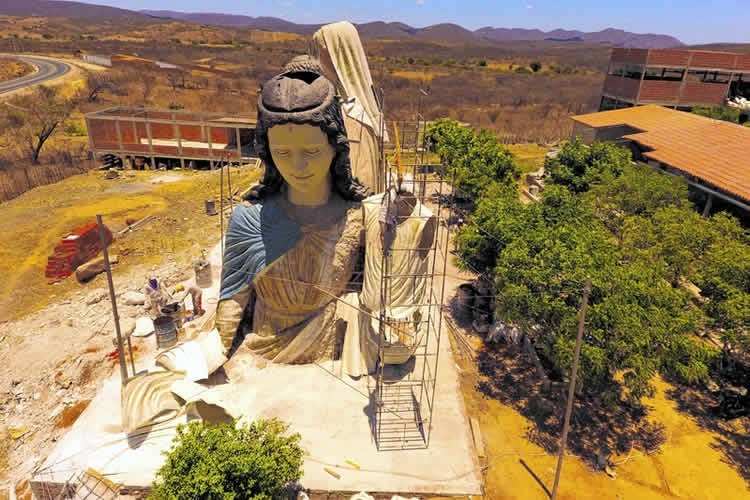Este post também está disponível em:
Português
English

Ceará is a state with strong religious representation.
In the interior, at least four cities have Catholicism very present in the figures of Padre Cícero (Juazeiro do Norte), Nossa Senhora de Fátima (Crato), Benigna (Santana do Cariri) and São Francisco das Chagas (Canindé).
These municipalities are interconnected in the so-called “route of faith”, when pilgrims migrate from one city to another for Catholic celebrations.
Added to the natural wealth and creativity of the crafts of the Cariri Region in Ceará, is religious tourism.
Starting with Juazeiro do Norte, land of Father Cícero Romão Batista, the “Padim Ciço”, which alone receives 3.0 million visitors between curious and devotees of the Father.
Most visitors go to Juazeiro do Norte for the pilgrimages. “A lot of people from Ceará come and many from other states in the Northeast as well.
Especially from Pernambuco and Alagoas, between October 29 and November 2, when the pilgrimage to the tomb of Padre Cícero, the second largest in the country, the city receives 500,000 visitors.
The religious pilgrimage points in Juazeiro do Norte are mandatory stops for most pilgrims and onlookers.

The route begins at the tomb of Padre Cícero in the Capela do Socorro. Then, the stops are: the first church of Juazeiro do Norte, the Basilica of Nossa Senhora das Dores and the Memorial of Padre Cícero, which houses an exhibition with objects used by him throughout his life.

The house of the “Padim” is also open to the public for visits.
At the top of Horto Hill, there is the 27-meter-high statue of Padre Cícero. At the foot of the monument, thousands of faithful write requests and thank the graces achieved, in addition to enjoying the view provided by one of the most beautiful landscapes in the municipality.
The statue has 41 years of existence and was renovated this year in celebration of the Centenary of Emancipation of Juazeiro do Norte.
From Horto Hill, according to Secretary Santos, the pilgrimage follows a three-kilometer trail.
At the end of the trail, there is a meditation space for the pilgrims, with chapels and preserved landscapes. Meditation continues at the Sanctuary of the Franciscans, where a grotto provides the famous “Walk of Souls”.


Juazeiro do Norte no Ceará

Estátua do Padre Cicero em Juazeiro do Norte CE

Juazeiro do Norte CE - História

Museu Paleontologia de Santana de Cariri
Commerce
Religious tourism boosts local trade. 90% of the money that circulates in the city with the pilgrimages is in informal trade.
And handicraft production is the most sought after: wooden and clay saints, amulets, replicas of body parts used by payers of promises, ribbons, rosaries, among others. But there are also formal trade options, such as the Centro de Apoio ao Romeiro.
Religious tourism in other northeastern cities

Pontos turísticos religiosos no Cariri CE
Most cities in Cariri receive religious tourism. Some, however, with stronger movements than others.
1. Milagres
In Milagres in Cariri, for example, 475 km from Fortaleza, visits in honor of the patron saint Nossa Senhora dos Milagres is still shy.
2. Barbalha
But, in the neighboring Barbalha in Cariri, the celebration of the “Festa do Pau de Santo Antônio” or Festa do Pau da Bandeira is already internationally known.
Barbalha, besides the beautiful formations of cerrado and caatinga, is an annual meeting point for single women. In the month of July, homage is paid to the “matchmaker” Saint Anthony, patron saint of the city. Thousands of visitors come to Barbalha to take part in the festivities.
The most striking fact of the celebrations is the flag stick, a traditional rite practiced since the times of the Empire and which is divided into two phases. In the first, dozens of devotees enter the Chapada do Araripe to extract a tree trunk, which is left in the middle of the forest to dry.
The second phase is the “procession of the stick” and begins a few days after the wood is cut.
Devotees pick up the cut log, carry it on their shoulders to the city center and raise it in front of the Mother Church of Santo Antônio with a flag of the saint.
Thousands of people fill the streets of Barbalha to witness the procession and try to touch the trunk. Mainly single women, it is believed that the ”ritual” increases the chances of getting married.
3. Santana do Cariri
Another city that has grown in religious tourism is Santana do Cariri.
Most visitors are looking to visit the Memorial of the Martyr Benigna, a small chapel built with rolled limestone stones in honor of the 13-year-old teenager who died to protect chastity.
According to researcher and historian João Paulo Cabral Alves, about 4,000 people accompanied Benigna’s pilgrimage in October this year.

“It deviates from Catholic standards. She starts from a spontaneous canonization made by the people. She is a saint for them”, explains the researcher. Other points that have received more and more visitors, according to Alves, are the Pontal da Santa Cruz geosite and the Mother Church.
According to the researcher, the Pontal da Santa Cruz takes its name because at the end of the 19th century residents built a large cross on the site to ward off a demon that haunted the village.
Currently, a large steel cross marks the place. The Mother Church, on the other hand, has a centennial architecture and receives faithful and curious people from all over the Northeast.
4. Campos Sales
In the city of Campos Sales in Cariri, the Mirante de Nossa Senhora da Penha was erected, which is the patron saint of the municipality.
At 26 meters high, the sculpture will become the fourth largest religious monument in Ceará, behind only the images of Our Lady of Fatima, St. Francis of the Wounds and Father Cicero;
The statue will be located in the rural area of Campos Sales, but only two kilometers from the city center.
5. Salvador da Bahia
The religious tourism in Salvador da Bahia grows annually and attracts more and more crowds in pilgrimages and events throughout the country. Religious tourism in Salvador da Bahia in the temples of faith and culture.
The religious tourism in Salvador such as events like the pilgrimage of Bom Jesus da Lapa and the masses in honor of Sister Dulce generate a global flow of approximately 1.5 million visitors to the state of Bahia.
They are tourists moved by faith, who cross hundreds of kilometers to ask for protection and thank for blessings.
Legend has it that Salvador (BA) would have 365 churches, one for each day of the year.
6. Nova Jerusalem (Fazenda Nova) – Pernambuco
Considered the largest open-air theater in the world, the 100,000-square-meter theater city of Nova Jerusalem gathers thousands of people every year to watch the spectacle of the Passion of Christ during Holy Week.
For more than 45 years, tourists have visited Fazenda Nova with caravans and excursions to see the site and see nationally known artists playing biblical characters up close.
The theater founded by Plínio Pacheco from Pernambuco between 1951 and 1952 has nine stage-platforms, which reproduce natural scenarios, and replicas of palaces, which promote an immersive experience for the public. An option for those looking for religious tourism, culture and good accommodation options within the theater city itself.
7. Canindé – Ceará
In the Sertão do Ceará, the city of Canindé, located 110km from Fortaleza, in Ceará, is known for its devotion to São Francisco das Chagas. There are indications that the municipality was born in 1758, from expeditions of Franciscan friars.

Devotion to the saint makes the municipality receive thousands of faithful every year between September 29 and October 4.
One of the main tourist attractions of the city is a 30-meter-high monument in honor of St. Francis, located on the hill of the mill, which represents the devotion of the faithful and makes the city known nationally.
Inside the statue, tourists can climb a staircase with 125 steps to a viewpoint that is inside. Another popular spot for tourists is the Basilica of St. Francis, founded in 1775, and the House of Miracles.
8. Historical site of Olinda – Pernambuco
With more than 500 years of history, historical site of Olinda, in Pernambuco, offers options to tourists, ranging from visiting religious places to places marked by revelry.

Documentário Igreja do Carmo de Olinda
It is possible to visit the Church of Carmo de Olinda, one of the oldest in Brazil, founded in 1588.
It is also possible to visit the Convent of São Francisco, founded in 1577, the first dedicated to the Franciscan order in Brazil. In it is kept the first library created in Olinda and the third created in the whole country.

Convento de São Francisco em Olinda
It is also possible to visit three museums: regional, contemporary art and sacred art. The Igreja da Sé, founded in 1537, is one of the most popular tourist spots in the city. From there, you can see the cities of Olinda and Recife from above. A place for those who want to record the moment in the upper city overlooking the sea;
Religious tourism in the northeast



















